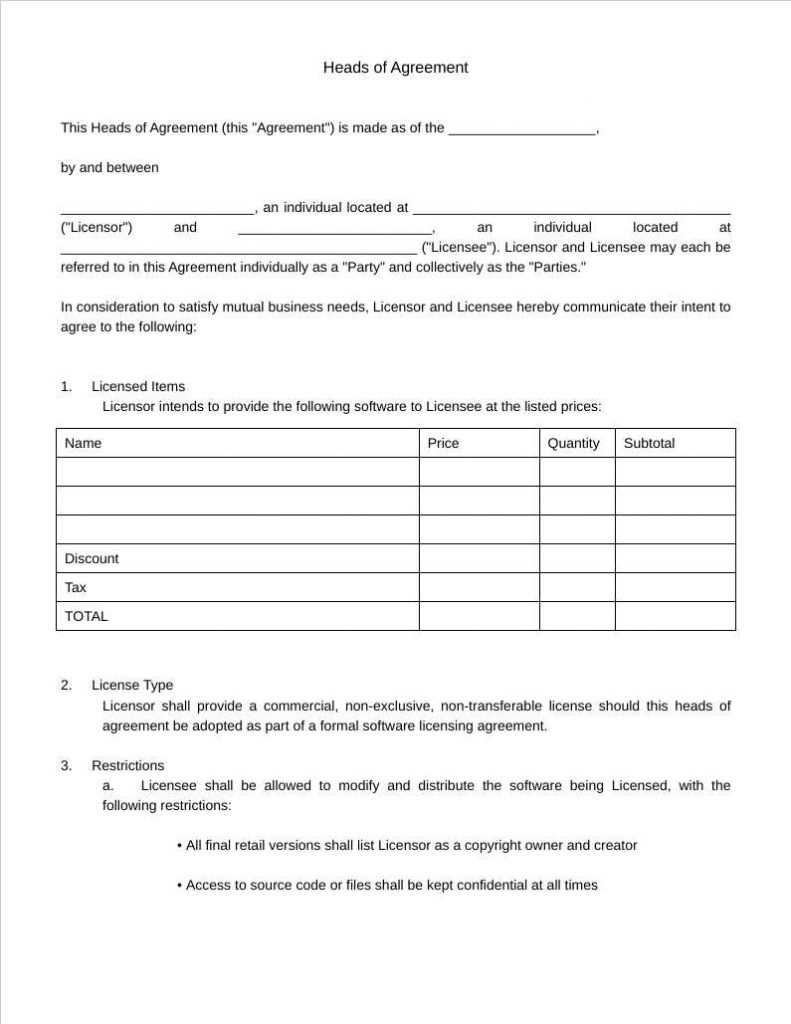What is a Heads of Agreement?
The Heads of Agreement is typically a non-binding document, meaning that it does not create a legally enforceable contract. Instead, it sets out the key points of the agreement and provides a basis for further discussions and negotiations. It is often used in complex business transactions, such as mergers and acquisitions, joint ventures, or partnerships.
Once the Heads of Agreement is signed, the parties can proceed with the negotiation process and work towards finalizing the terms of the agreement. At this stage, they may seek legal advice and engage in further due diligence to ensure that all aspects of the agreement are properly addressed.
The Purpose of Heads of Agreement
The purpose of a Heads of Agreement (HOA) is to outline the key terms and conditions of a proposed agreement between two or more parties. It serves as a preliminary document that sets out the main points of the agreement before the parties proceed to negotiate and finalize a formal contract.
Another purpose of a HOA is to provide a level of commitment between the parties involved. While a HOA is not legally binding in itself, it can create a moral or ethical obligation for the parties to negotiate in good faith and work towards reaching a final agreement. It demonstrates the seriousness of the parties’ intent to enter into a formal agreement and can help build trust and confidence between them.
A HOA also serves as a roadmap for the parties to follow during the negotiation process. It outlines the key terms and conditions that need to be addressed and provides a structure for the discussions. This can help to ensure that all important aspects of the agreement are considered and agreed upon before moving forward.
Additionally, a HOA can be used to secure financing or attract investors. By having a preliminary agreement in place, parties may be able to demonstrate to potential lenders or investors that they have a solid foundation for their business venture. This can help to instill confidence and increase the likelihood of obtaining the necessary funding or support.
In summary, the purpose of a Heads of Agreement is to provide a framework for negotiation, establish commitment between parties, serve as a roadmap for discussions, and potentially attract financing or investors. It is an important preliminary document that helps to set the stage for the formal agreement that will follow.
Binding Status of Heads of Agreement
When entering into a Heads of Agreement, it is important to understand the binding status of the document. While a Heads of Agreement is not typically intended to be legally binding, there are certain circumstances where it can be enforceable.
The binding status of a Heads of Agreement depends on the intentions of the parties involved and the language used in the document. If the parties clearly express their intention to be bound by the terms outlined in the Heads of Agreement, it can be considered legally binding.
However, if the document is labeled as “subject to contract” or “non-binding,” it indicates that the parties do not intend to be legally bound by the terms at this stage. In such cases, the Heads of Agreement serves as a preliminary agreement to outline the main terms and conditions of a future contract.
It is important to note that even if a Heads of Agreement is not legally binding, it can still have practical implications. For example, it can create a moral obligation for the parties to negotiate in good faith and work towards finalizing a formal contract.
In some jurisdictions, a Heads of Agreement may be considered legally binding if it satisfies certain requirements, such as including all essential terms, being signed by the parties, and demonstrating an intention to create legal relations. It is advisable to seek legal advice to determine the binding status of a Heads of Agreement in a specific jurisdiction.
Conclusion
Heads of Agreement in Business Essentials

While Heads of Agreement is a significant step in the negotiation process, it is important to note that it is typically not legally binding. However, certain provisions within the document may be binding, such as confidentiality or exclusivity agreements. It is crucial for the parties to clearly define the binding and non-binding provisions to avoid any confusion or disputes.
| Benefits of Heads of Agreement in Business Essentials |
|---|
| 2. Helps to identify and address potential issues early on |
| 3. Establishes a framework for the future contract |
| 5. Streamlines the negotiation process |

Emily Bibb simplifies finance through bestselling books and articles, bridging complex concepts for everyday understanding. Engaging audiences via social media, she shares insights for financial success. Active in seminars and philanthropy, Bibb aims to create a more financially informed society, driven by her passion for empowering others.
